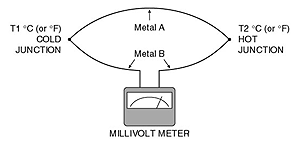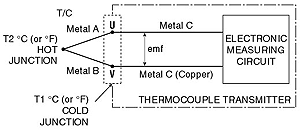| A pair of junctions between two dissimilar metals
generates emf when they are at different temperatures. This phenomenon
is called the Seebeck Effect. The emf depends on the combination of
dissimilar metals and temperature difference between the junction.
However, it does not depend on the shape of the wires and volume of
metals used. The emf can be measured with a meter in the circuit (See
the figures). |

Figure 1 |
When one junction, called the cold junction or reference
junction, is kept at a constant temperature, for example 0°C or
32°F, the emf is determined only by the temperature at the other
junction. This junction is called the hot junction or the measurement
junction. In such a setup, we know the temperature at the hot junction
from the emf.
|
| Figure 2 shows a variation of the Figure 1 setup.
In addition to the thermocouple wires A and B, wires of the third
metal C, typically copper, are connected. The junction U between metals
A and C and the junction V between metals B and C become the cold
junction. As long as junctions U and V are at the same temperature
T1, the emf between U and V is equal to that of the metals A and B
only, like that of Figure 1. Figure 2 represents a typical circuit
of a thermocouple transmitter. U and V are the input terminals of
the transmitter. Inside the transmitter, copper wires are used for
connection between the terminals and the electronic measuring circuit. |

Figure 2 |
| M-System has flexible solutions to meet your specific
application and requirements. Consult our Signal Conditioners Data
Library. |
|
 What
is a thermocouple?
What
is a thermocouple?
 A
thermocouple is made of a pair of wires of different metals, such as iron
and copper, whose ends are welded together. The welded point is called the
"junction". When the junctions are at different temperatures,
as shown in Figure 1, the thermal electromotive force (emf, millivolt) is
generated between them. By measuring the emf, we know the temperature difference.
A
thermocouple is made of a pair of wires of different metals, such as iron
and copper, whose ends are welded together. The welded point is called the
"junction". When the junctions are at different temperatures,
as shown in Figure 1, the thermal electromotive force (emf, millivolt) is
generated between them. By measuring the emf, we know the temperature difference.